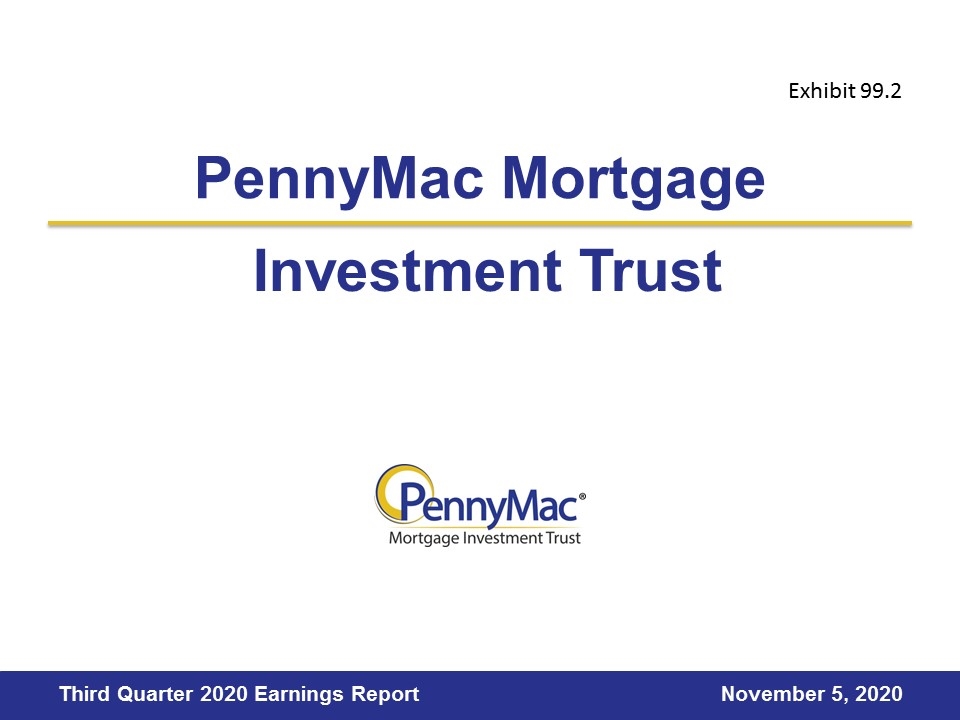
PennyMac Mortgage Investment Trust November 5, 2020 Third Quarter 2020 Earnings Report Exhibit 99.2
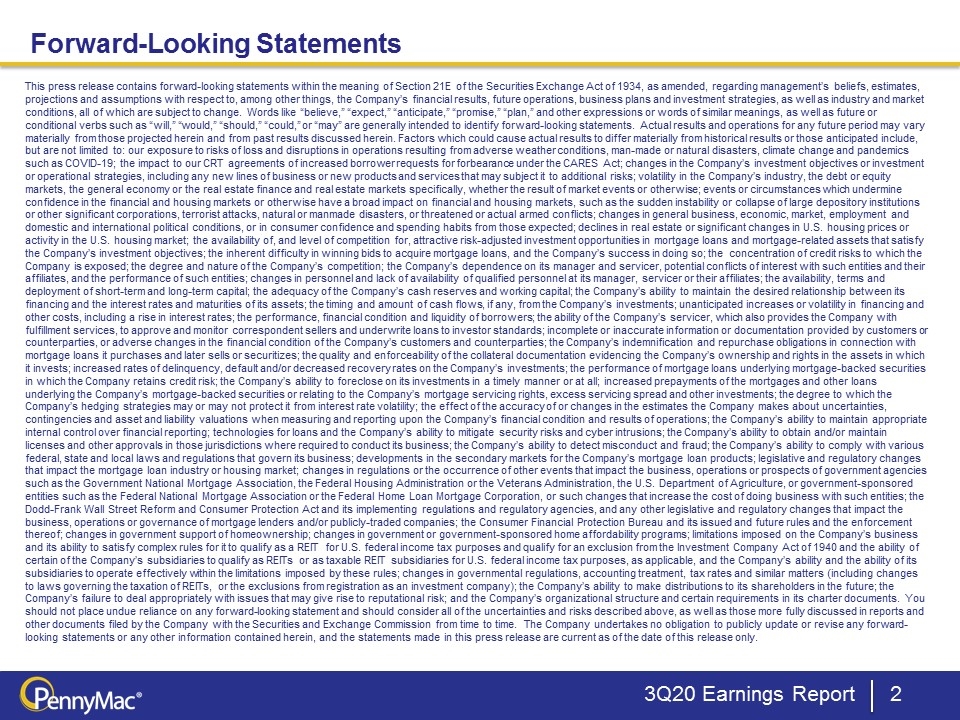
This press release contains forward-looking statements within the meaning of Section 21E of the Securities Exchange Act of 1934, as amended, regarding management’s beliefs, estimates, projections and assumptions with respect to, among other things, the Company’s financial results, future operations, business plans and investment strategies, as well as industry and market conditions, all of which are subject to change. Words like “believe,” “expect,” “anticipate,” “promise,” “plan,” and other expressions or words of similar meanings, as well as future or conditional verbs such as “will,” “would,” “should,” “could,” or “may” are generally intended to identify forward-looking statements. Actual results and operations for any future period may vary materially from those projected herein and from past results discussed herein. Factors which could cause actual results to differ materially from historical results or those anticipated include, but are not limited to: our exposure to risks of loss and disruptions in operations resulting from adverse weather conditions, man-made or natural disasters, climate change and pandemics such as COVID-19; the impact to our CRT agreements of increased borrower requests for forbearance under the CARES Act; changes in the Company’s investment objectives or investment or operational strategies, including any new lines of business or new products and services that may subject it to additional risks; volatility in the Company’s industry, the debt or equity markets, the general economy or the real estate finance and real estate markets specifically, whether the result of market events or otherwise; events or circumstances which undermine confidence in the financial and housing markets or otherwise have a broad impact on financial and housing markets, such as the sudden instability or collapse of large depository institutions or other significant corporations, terrorist attacks, natural or manmade disasters, or threatened or actual armed conflicts; changes in general business, economic, market, employment and domestic and international political conditions, or in consumer confidence and spending habits from those expected; declines in real estate or significant changes in U.S. housing prices or activity in the U.S. housing market; the availability of, and level of competition for, attractive risk-adjusted investment opportunities in mortgage loans and mortgage-related assets that satisfy the Company’s investment objectives; the inherent difficulty in winning bids to acquire mortgage loans, and the Company’s success in doing so; the concentration of credit risks to which the Company is exposed; the degree and nature of the Company’s competition; the Company’s dependence on its manager and servicer, potential conflicts of interest with such entities and their affiliates, and the performance of such entities; changes in personnel and lack of availability of qualified personnel at its manager, servicer or their affiliates; the availability, terms and deployment of short-term and long-term capital; the adequacy of the Company’s cash reserves and working capital; the Company’s ability to maintain the desired relationship between its financing and the interest rates and maturities of its assets; the timing and amount of cash flows, if any, from the Company’s investments; unanticipated increases or volatility in financing and other costs, including a rise in interest rates; the performance, financial condition and liquidity of borrowers; the ability of the Company’s servicer, which also provides the Company with fulfillment services, to approve and monitor correspondent sellers and underwrite loans to investor standards; incomplete or inaccurate information or documentation provided by customers or counterparties, or adverse changes in the financial condition of the Company’s customers and counterparties; the Company’s indemnification and repurchase obligations in connection with mortgage loans it purchases and later sells or securitizes; the quality and enforceability of the collateral documentation evidencing the Company’s ownership and rights in the assets in which it invests; increased rates of delinquency, default and/or decreased recovery rates on the Company’s investments; the performance of mortgage loans underlying mortgage-backed securities in which the Company retains credit risk; the Company’s ability to foreclose on its investments in a timely manner or at all; increased prepayments of the mortgages and other loans underlying the Company’s mortgage-backed securities or relating to the Company’s mortgage servicing rights, excess servicing spread and other investments; the degree to which the Company’s hedging strategies may or may not protect it from interest rate volatility; the effect of the accuracy of or changes in the estimates the Company makes about uncertainties, contingencies and asset and liability valuations when measuring and reporting upon the Company’s financial condition and results of operations; the Company’s ability to maintain appropriate internal control over financial reporting; technologies for loans and the Company’s ability to mitigate security risks and cyber intrusions; the Company’s ability to obtain and/or maintain licenses and other approvals in those jurisdictions where required to conduct its business; the Company’s ability to detect misconduct and fraud; the Company’s ability to comply with various federal, state and local laws and regulations that govern its business; developments in the secondary markets for the Company’s mortgage loan products; legislative and regulatory changes that impact the mortgage loan industry or housing market; changes in regulations or the occurrence of other events that impact the business, operations or prospects of government agencies such as the Government National Mortgage Association, the Federal Housing Administration or the Veterans Administration, the U.S. Department of Agriculture, or government-sponsored entities such as the Federal National Mortgage Association or the Federal Home Loan Mortgage Corporation, or such changes that increase the cost of doing business with such entities; the Dodd-Frank Wall Street Reform and Consumer Protection Act and its implementing regulations and regulatory agencies, and any other legislative and regulatory changes that impact the business, operations or governance of mortgage lenders and/or publicly-traded companies; the Consumer Financial Protection Bureau and its issued and future rules and the enforcement thereof; changes in government support of homeownership; changes in government or government-sponsored home affordability programs; limitations imposed on the Company’s business and its ability to satisfy complex rules for it to qualify as a REIT for U.S. federal income tax purposes and qualify for an exclusion from the Investment Company Act of 1940 and the ability of certain of the Company’s subsidiaries to qualify as REITs or as taxable REIT subsidiaries for U.S. federal income tax purposes, as applicable, and the Company’s ability and the ability of its subsidiaries to operate effectively within the limitations imposed by these rules; changes in governmental regulations, accounting treatment, tax rates and similar matters (including changes to laws governing the taxation of REITs, or the exclusions from registration as an investment company); the Company’s ability to make distributions to its shareholders in the future; the Company’s failure to deal appropriately with issues that may give rise to reputational risk; and the Company’s organizational structure and certain requirements in its charter documents. You should not place undue reliance on any forward-looking statement and should consider all of the uncertainties and risks described above, as well as those more fully discussed in reports and other documents filed by the Company with the Securities and Exchange Commission from time to time. The Company undertakes no obligation to publicly update or revise any forward-looking statements or any other information contained herein, and the statements made in this press release are current as of the date of this release only. Forward-Looking Statements 3Q20 Earnings Report
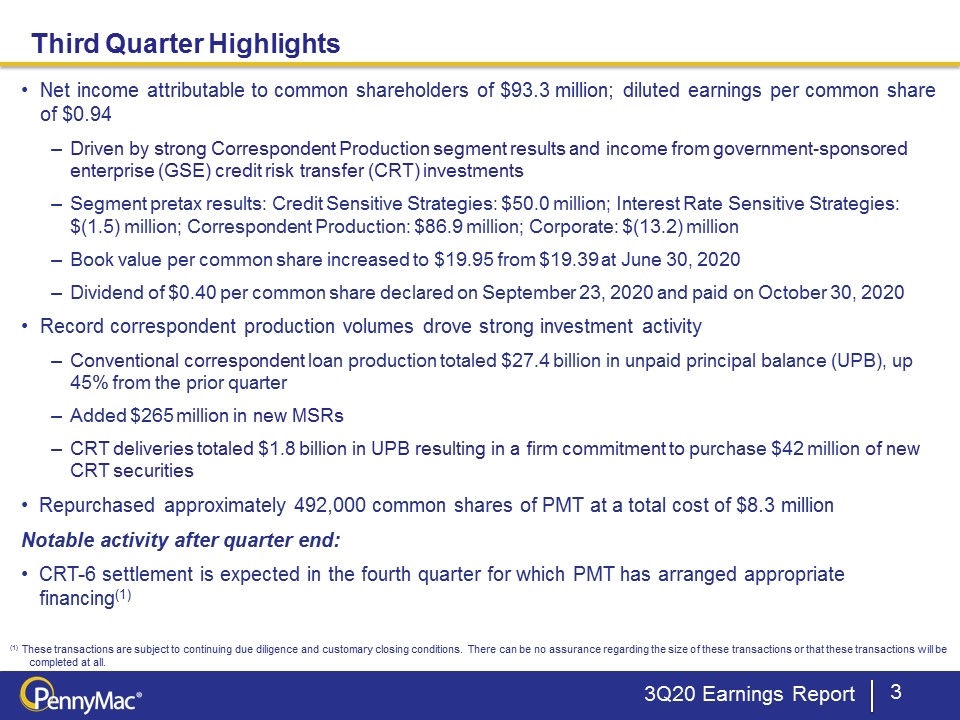
3Q20 Earnings Report Third Quarter Highlights Net income attributable to common shareholders of $93.3 million; diluted earnings per common share of $0.94 Driven by strong Correspondent Production segment results and income from government-sponsored enterprise (GSE) credit risk transfer (CRT) investments Segment pretax results: Credit Sensitive Strategies: $50.0 million; Interest Rate Sensitive Strategies: $(1.5) million; Correspondent Production: $86.9 million; Corporate: $(13.2) million Book value per common share increased to $19.95 from $19.39 at June 30, 2020 Dividend of $0.40 per common share declared on September 23, 2020 and paid on October 30, 2020 Record correspondent production volumes drove strong investment activity Conventional correspondent loan production totaled $27.4 billion in unpaid principal balance (UPB), up 45% from the prior quarter Added $265 million in new MSRs CRT deliveries totaled $1.8 billion in UPB resulting in a firm commitment to purchase $42 million of new CRT securities Repurchased approximately 492,000 common shares of PMT at a total cost of $8.3 million Notable activity after quarter end: CRT-6 settlement is expected in the fourth quarter for which PMT has arranged appropriate financing(1) (1) These transactions are subject to continuing due diligence and customary closing conditions. There can be no assurance regarding the size of these transactions or that these transactions will be completed at all.
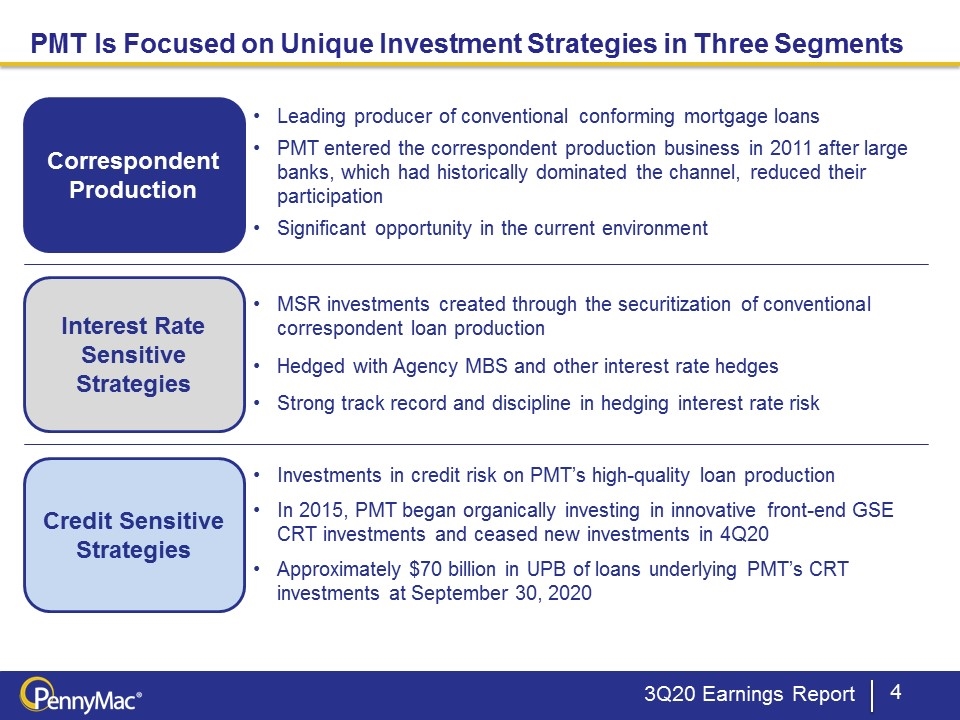
3Q20 Earnings Report PMT Is Focused on Unique Investment Strategies in Three Segments Correspondent Production Credit Sensitive Strategies Interest Rate Sensitive Strategies Leading producer of conventional conforming mortgage loans PMT entered the correspondent production business in 2011 after large banks, which had historically dominated the channel, reduced their participation Significant opportunity in the current environment Investments in credit risk on PMT’s high-quality loan production In 2015, PMT began organically investing in innovative front-end GSE CRT investments and ceased new investments in 4Q20 Approximately $70 billion in UPB of loans underlying PMT’s CRT investments at September 30, 2020 MSR investments created through the securitization of conventional correspondent loan production Hedged with Agency MBS and other interest rate hedges Strong track record and discipline in hedging interest rate risk
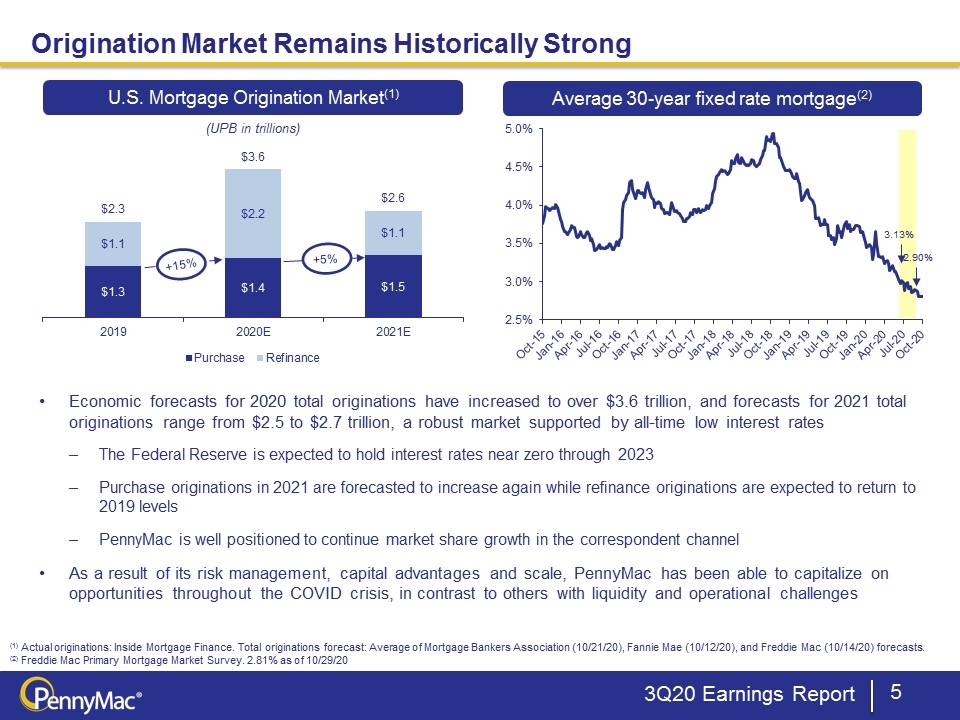
3Q20 Earnings Report Origination Market Remains Historically Strong (1) Actual originations: Inside Mortgage Finance. Total originations forecast: Average of Mortgage Bankers Association (10/21/20), Fannie Mae (10/12/20), and Freddie Mac (10/14/20) forecasts. (2) Freddie Mac Primary Mortgage Market Survey. 2.81% as of 10/29/20 U.S. Mortgage Origination Market(1) (UPB in trillions) Average 30-year fixed rate mortgage(2) 3.13% 2.90% Economic forecasts for 2020 total originations have increased to over $3.6 trillion, and forecasts for 2021 total originations range from $2.5 to $2.7 trillion, a robust market supported by all-time low interest rates The Federal Reserve is expected to hold interest rates near zero through 2023 Purchase originations in 2021 are forecasted to increase again while refinance originations are expected to return to 2019 levels PennyMac is well positioned to continue market share growth in the correspondent channel As a result of its risk management, capital advantages and scale, PennyMac has been able to capitalize on opportunities throughout the COVID crisis, in contrast to others with liquidity and operational challenges +15% +5%
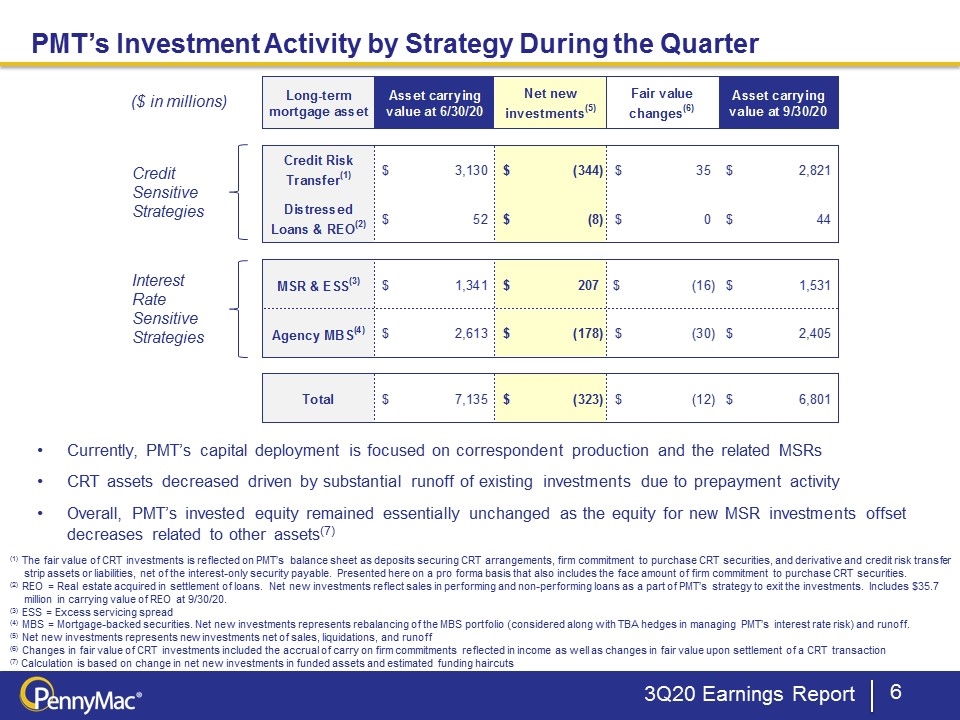
3Q20 Earnings Report PMT’s Investment Activity by Strategy During the Quarter Credit Sensitive Strategies Interest Rate Sensitive Strategies ($ in millions) Currently, PMT’s capital deployment is focused on correspondent production and the related MSRs CRT assets decreased driven by substantial runoff of existing investments due to prepayment activity Overall, PMT’s invested equity remained essentially unchanged as the equity for new MSR investments offset decreases related to other assets(7) (1) The fair value of CRT investments is reflected on PMT’s balance sheet as deposits securing CRT arrangements, firm commitment to purchase CRT securities, and derivative and credit risk transfer strip assets or liabilities, net of the interest-only security payable. Presented here on a pro forma basis that also includes the face amount of firm commitment to purchase CRT securities. (2) REO = Real estate acquired in settlement of loans. Net new investments reflect sales in performing and non-performing loans as a part of PMT’s strategy to exit the investments. Includes $35.7 million in carrying value of REO at 9/30/20. (3) ESS = Excess servicing spread (4) MBS = Mortgage-backed securities. Net new investments represents rebalancing of the MBS portfolio (considered along with TBA hedges in managing PMT’s interest rate risk) and runoff. (5) Net new investments represents new investments net of sales, liquidations, and runoff (6) Changes in fair value of CRT investments included the accrual of carry on firm commitments reflected in income as well as changes in fair value upon settlement of a CRT transaction (7) Calculation is based on change in net new investments in funded assets and estimated funding haircuts
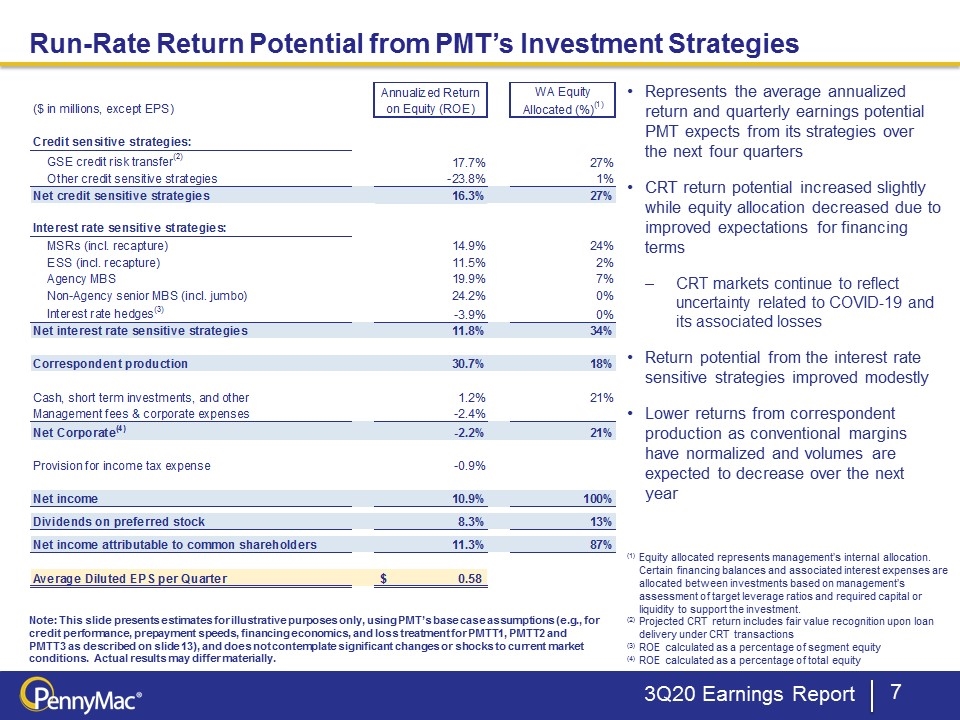
3Q20 Earnings Report Run-Rate Return Potential from PMT’s Investment Strategies Note: This slide presents estimates for illustrative purposes only, using PMT’s base case assumptions (e.g., for credit performance, prepayment speeds, financing economics, and loss treatment for PMTT1, PMTT2 and PMTT3 as described on slide 13), and does not contemplate significant changes or shocks to current market conditions. Actual results may differ materially. (1) Equity allocated represents management’s internal allocation. Certain financing balances and associated interest expenses are allocated between investments based on management’s assessment of target leverage ratios and required capital or liquidity to support the investment. (2) Projected CRT return includes fair value recognition upon loan delivery under CRT transactions (3) ROE calculated as a percentage of segment equity (4) ROE calculated as a percentage of total equity Represents the average annualized return and quarterly earnings potential PMT expects from its strategies over the next four quarters CRT return potential increased slightly while equity allocation decreased due to improved expectations for financing terms CRT markets continue to reflect uncertainty related to COVID-19 and its associated losses Return potential from the interest rate sensitive strategies improved modestly Lower returns from correspondent production as conventional margins have normalized and volumes are expected to decrease over the next year
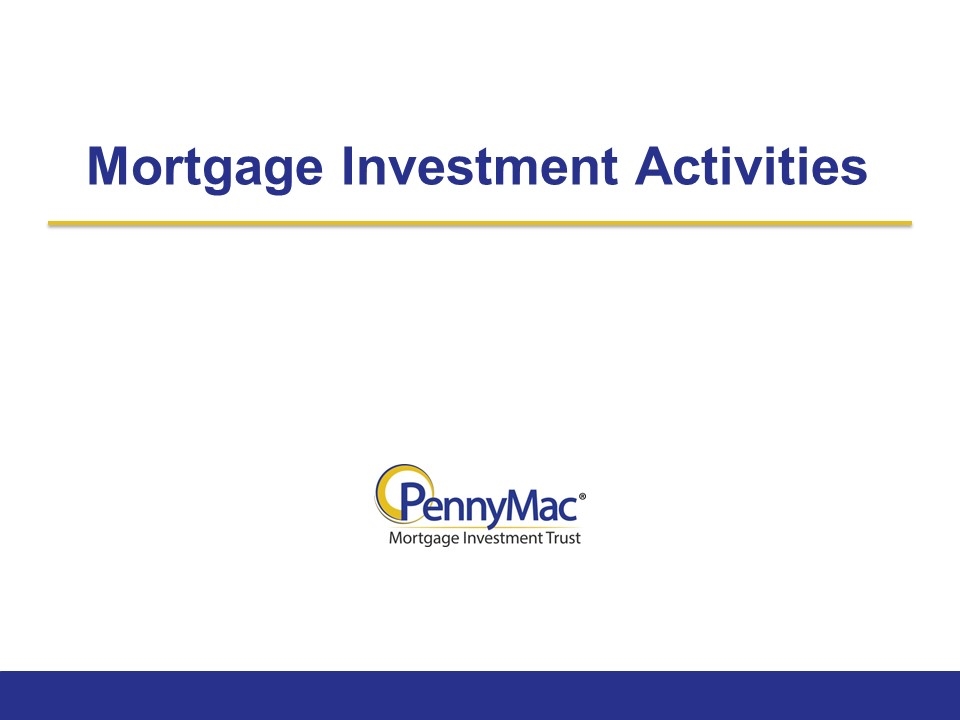
Mortgage Investment Activities
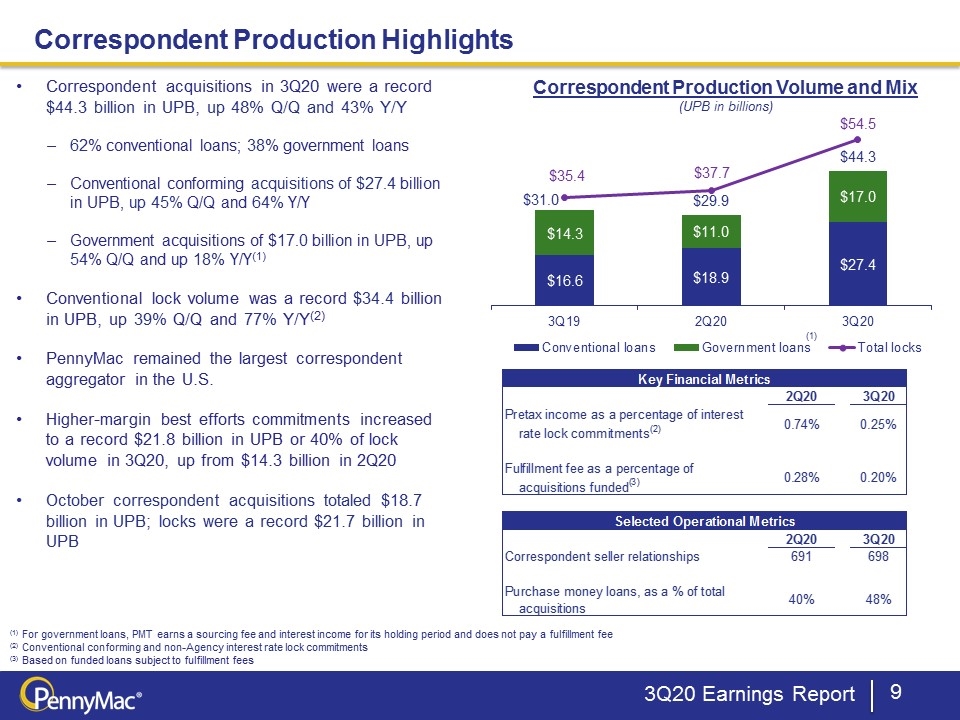
3Q20 Earnings Report Correspondent Production Highlights Correspondent Production Volume and Mix (UPB in billions) (1) For government loans, PMT earns a sourcing fee and interest income for its holding period and does not pay a fulfillment fee (2) Conventional conforming and non-Agency interest rate lock commitments (3) Based on funded loans subject to fulfillment fees (1) Correspondent acquisitions in 3Q20 were a record $44.3 billion in UPB, up 48% Q/Q and 43% Y/Y 62% conventional loans; 38% government loans Conventional conforming acquisitions of $27.4 billion in UPB, up 45% Q/Q and 64% Y/Y Government acquisitions of $17.0 billion in UPB, up 54% Q/Q and up 18% Y/Y(1) Conventional lock volume was a record $34.4 billion in UPB, up 39% Q/Q and 77% Y/Y(2) PennyMac remained the largest correspondent aggregator in the U.S. Higher-margin best efforts commitments increased to a record $21.8 billion in UPB or 40% of lock volume in 3Q20, up from $14.3 billion in 2Q20 October correspondent acquisitions totaled $18.7 billion in UPB; locks were a record $21.7 billion in UPB
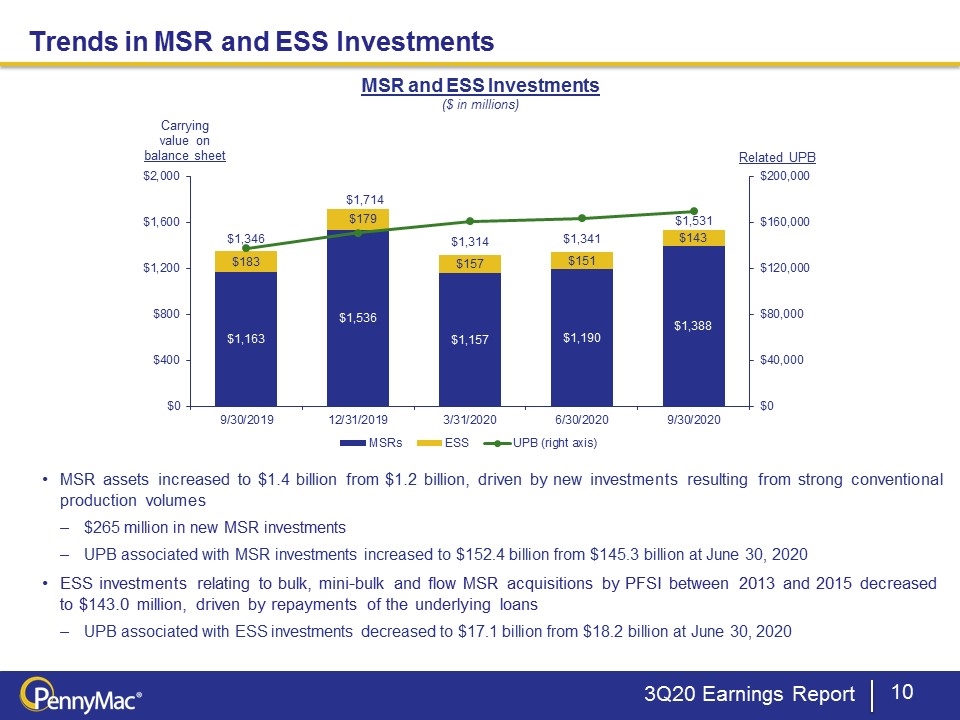
3Q20 Earnings Report Trends in MSR and ESS Investments MSR assets increased to $1.4 billion from $1.2 billion, driven by new investments resulting from strong conventional production volumes $265 million in new MSR investments UPB associated with MSR investments increased to $152.4 billion from $145.3 billion at June 30, 2020 ESS investments relating to bulk, mini-bulk and flow MSR acquisitions by PFSI between 2013 and 2015 decreased to $143.0 million, driven by repayments of the underlying loans UPB associated with ESS investments decreased to $17.1 billion from $18.2 billion at June 30, 2020 MSR and ESS Investments ($ in millions)
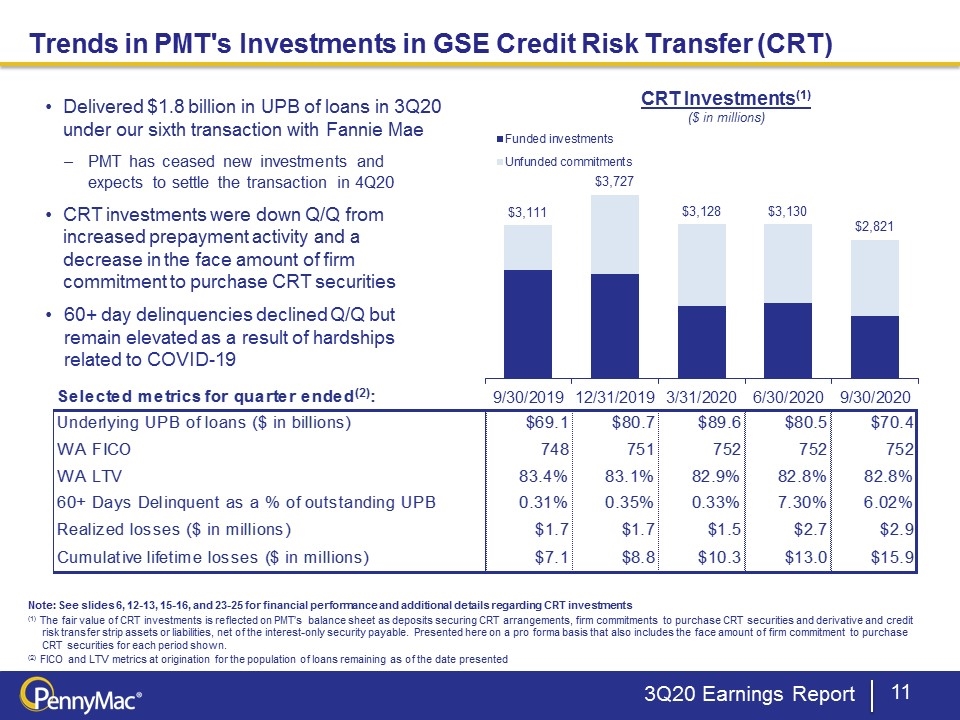
3Q20 Earnings Report Trends in PMT's Investments in GSE Credit Risk Transfer (CRT) Delivered $1.8 billion in UPB of loans in 3Q20 under our sixth transaction with Fannie Mae PMT has ceased new investments and expects to settle the transaction in 4Q20 CRT investments were down Q/Q from increased prepayment activity and a decrease in the face amount of firm commitment to purchase CRT securities 60+ day delinquencies declined Q/Q but remain elevated as a result of hardships related to COVID-19 Note: See slides 6, 12-13, 15-16, and 23-25 for financial performance and additional details regarding CRT investments (1) The fair value of CRT investments is reflected on PMT’s balance sheet as deposits securing CRT arrangements, firm commitments to purchase CRT securities and derivative and credit risk transfer strip assets or liabilities, net of the interest-only security payable. Presented here on a pro forma basis that also includes the face amount of firm commitment to purchase CRT securities for each period shown. (2) FICO and LTV metrics at origination for the population of loans remaining as of the date presented CRT Investments(1) ($ in millions)
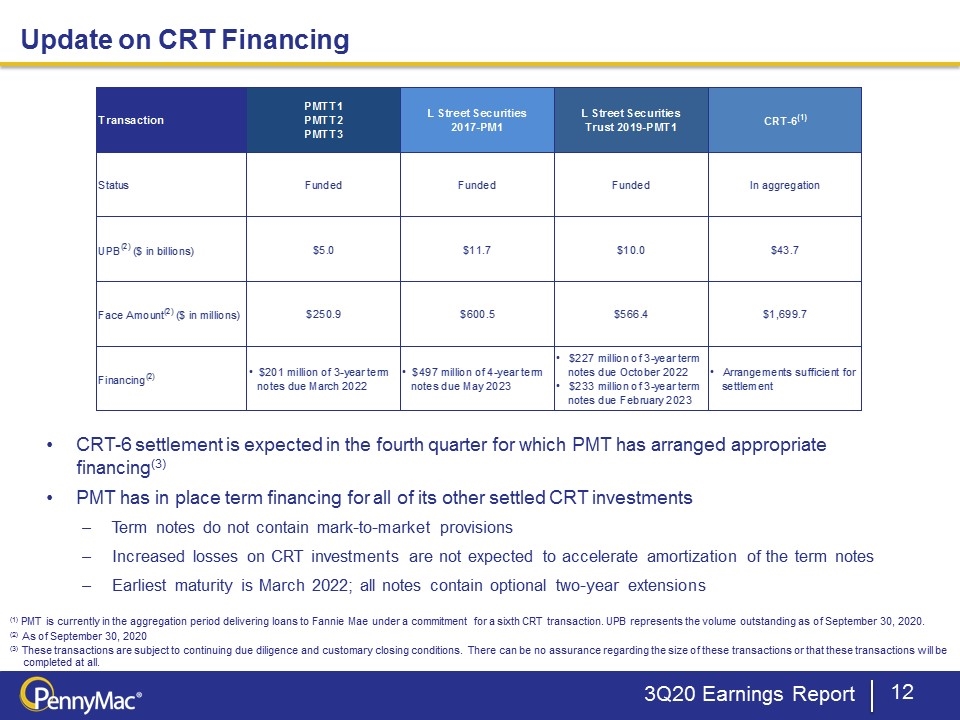
3Q20 Earnings Report Update on CRT Financing (1) PMT is currently in the aggregation period delivering loans to Fannie Mae under a commitment for a sixth CRT transaction. UPB represents the volume outstanding as of September 30, 2020. (2) As of September 30, 2020 (3) These transactions are subject to continuing due diligence and customary closing conditions. There can be no assurance regarding the size of these transactions or that these transactions will be completed at all. CRT-6 settlement is expected in the fourth quarter for which PMT has arranged appropriate financing(3) PMT has in place term financing for all of its other settled CRT investments Term notes do not contain mark-to-market provisions Increased losses on CRT investments are not expected to accelerate amortization of the term notes Earliest maturity is March 2022; all notes contain optional two-year extensions
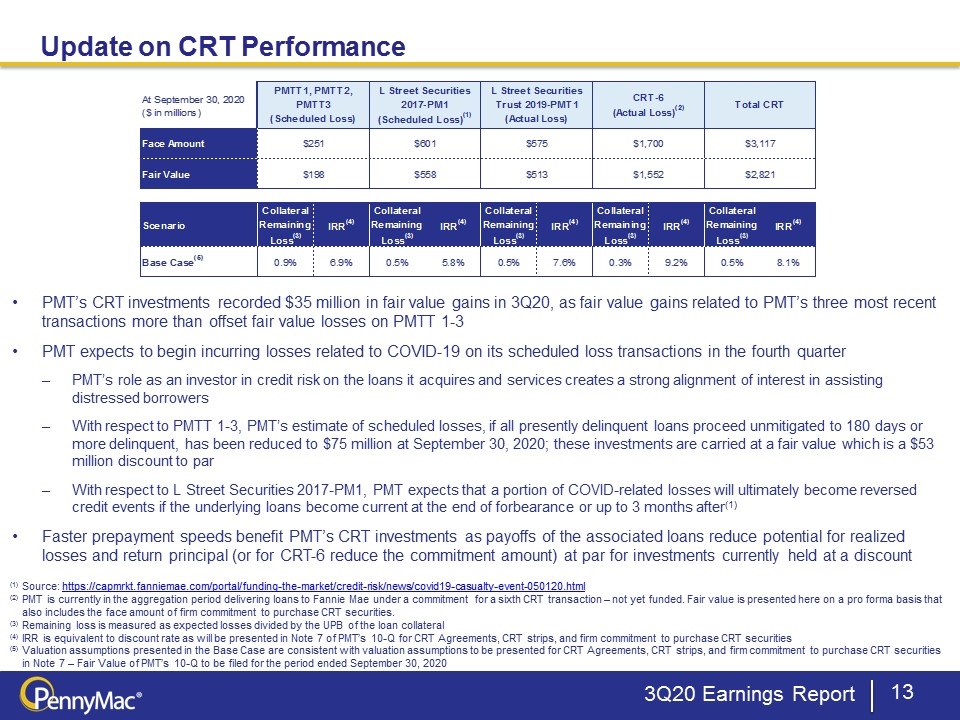
3Q20 Earnings Report Update on CRT Performance (1) Source: https://capmrkt.fanniemae.com/portal/funding-the-market/credit-risk/news/covid19-casualty-event-050120.html (2) PMT is currently in the aggregation period delivering loans to Fannie Mae under a commitment for a sixth CRT transaction – not yet funded. Fair value is presented here on a pro forma basis that also includes the face amount of firm commitment to purchase CRT securities. (3) Remaining loss is measured as expected losses divided by the UPB of the loan collateral (4) IRR is equivalent to discount rate as will be presented in Note 7 of PMT’s 10-Q for CRT Agreements, CRT strips, and firm commitment to purchase CRT securities (5) Valuation assumptions presented in the Base Case are consistent with valuation assumptions to be presented for CRT Agreements, CRT strips, and firm commitment to purchase CRT securities in Note 7 – Fair Value of PMT’s 10-Q to be filed for the period ended September 30, 2020 PMT’s CRT investments recorded $35 million in fair value gains in 3Q20, as fair value gains related to PMT’s three most recent transactions more than offset fair value losses on PMTT 1-3 PMT expects to begin incurring losses related to COVID-19 on its scheduled loss transactions in the fourth quarter PMT’s role as an investor in credit risk on the loans it acquires and services creates a strong alignment of interest in assisting distressed borrowers With respect to PMTT 1-3, PMT’s estimate of scheduled losses, if all presently delinquent loans proceed unmitigated to 180 days or more delinquent, has been reduced to $75 million at September 30, 2020; these investments are carried at a fair value which is a $53 million discount to par With respect to L Street Securities 2017-PM1, PMT expects that a portion of COVID-related losses will ultimately become reversed credit events if the underlying loans become current at the end of forbearance or up to 3 months after(1) Faster prepayment speeds benefit PMT’s CRT investments as payoffs of the associated loans reduce potential for realized losses and return principal (or for CRT-6 reduce the commitment amount) at par for investments currently held at a discount
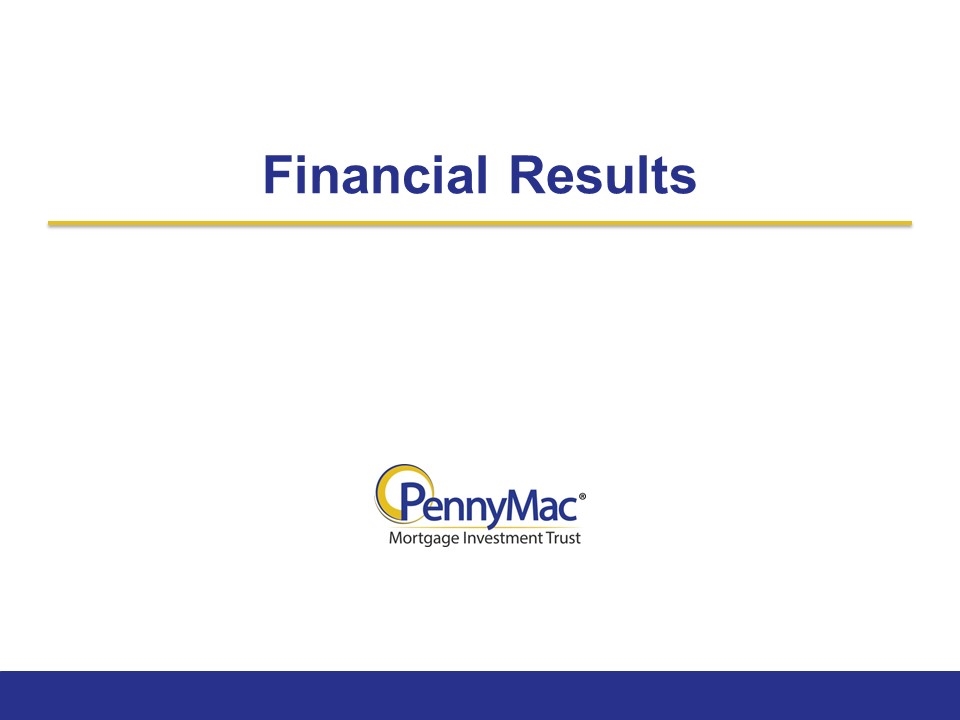
Financial Results
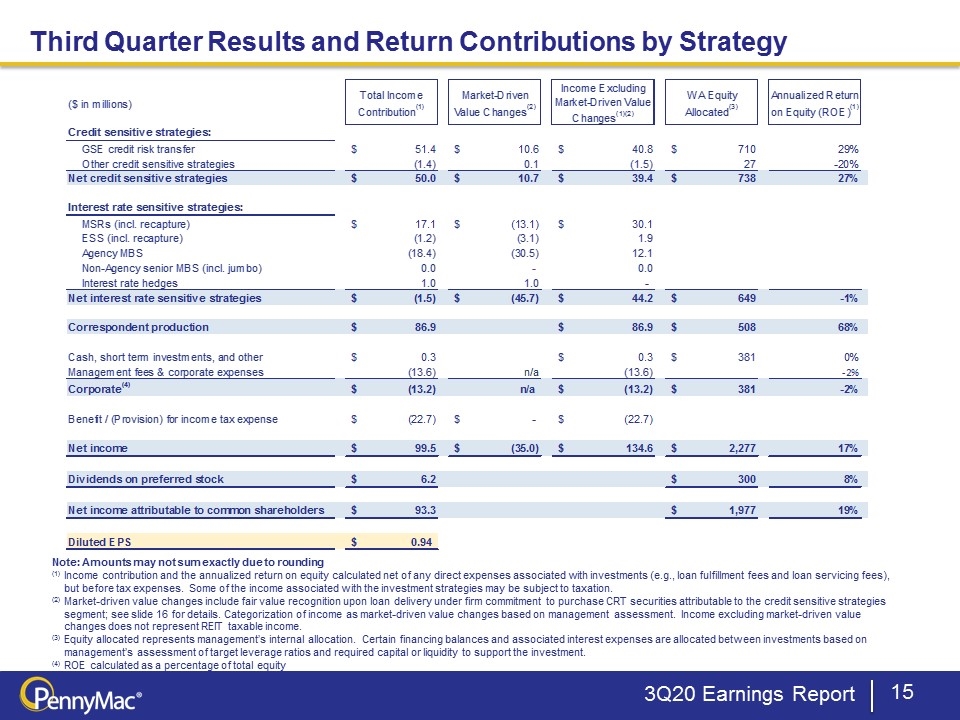
3Q20 Earnings Report Note: Amounts may not sum exactly due to rounding (1) Income contribution and the annualized return on equity calculated net of any direct expenses associated with investments (e.g., loan fulfillment fees and loan servicing fees), but before tax expenses. Some of the income associated with the investment strategies may be subject to taxation. (2) Market-driven value changes include fair value recognition upon loan delivery under firm commitment to purchase CRT securities attributable to the credit sensitive strategies segment; see slide 16 for details. Categorization of income as market-driven value changes based on management assessment. Income excluding market-driven value changes does not represent REIT taxable income. (3) Equity allocated represents management’s internal allocation. Certain financing balances and associated interest expenses are allocated between investments based on management’s assessment of target leverage ratios and required capital or liquidity to support the investment. (4) ROE calculated as a percentage of total equity Third Quarter Results and Return Contributions by Strategy
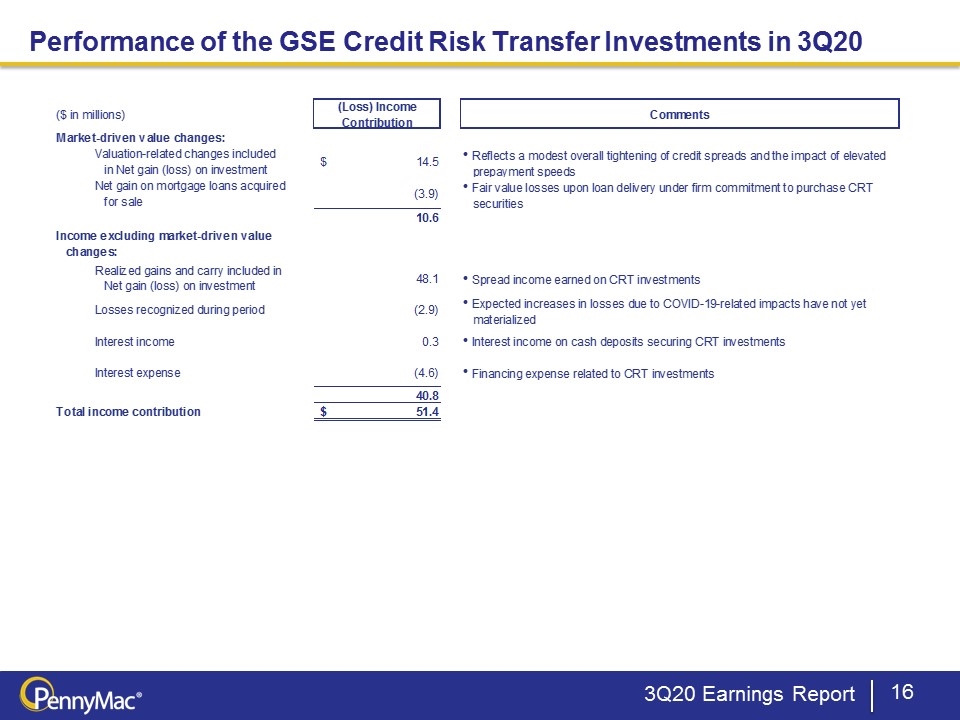
3Q20 Earnings Report Performance of the GSE Credit Risk Transfer Investments in 3Q20
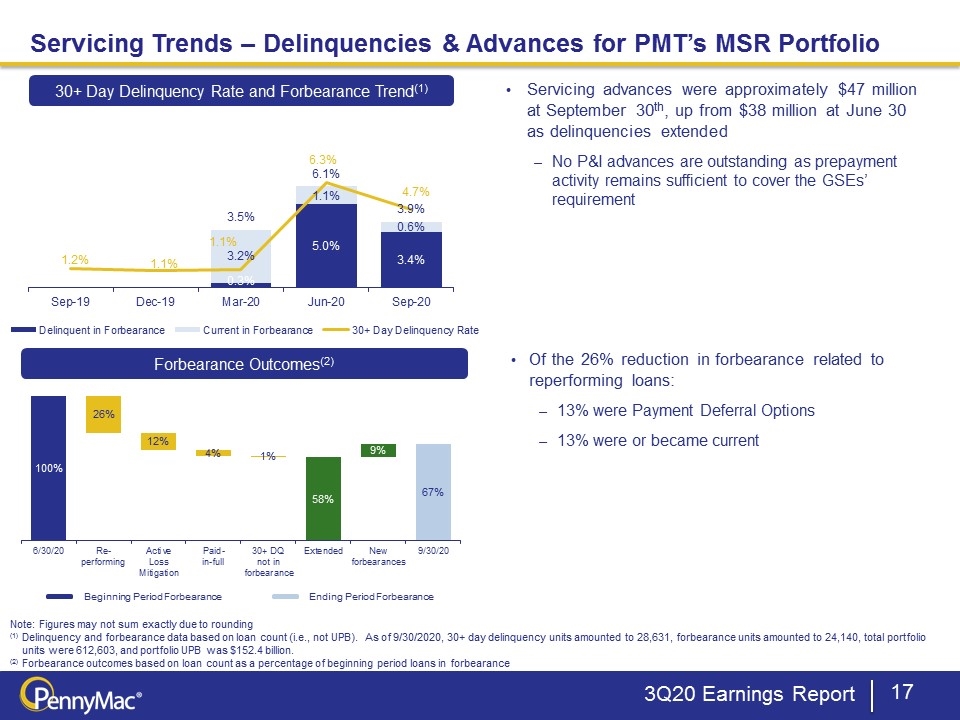
Servicing Trends – Delinquencies & Advances for PMT’s MSR Portfolio 3Q20 Earnings Report Servicing advances were approximately $47 million at September 30th, up from $38 million at June 30 as delinquencies extended No P&I advances are outstanding as prepayment activity remains sufficient to cover the GSEs’ requirement 30+ Day Delinquency Rate and Forbearance Trend(1) Forbearance Outcomes(2) Note: Figures may not sum exactly due to rounding (1) Delinquency and forbearance data based on loan count (i.e., not UPB). As of 9/30/2020, 30+ day delinquency units amounted to 28,631, forbearance units amounted to 24,140, total portfolio units were 612,603, and portfolio UPB was $152.4 billion. (2) Forbearance outcomes based on loan count as a percentage of beginning period loans in forbearance Beginning Period Forbearance Ending Period Forbearance Of the 26% reduction in forbearance related to reperforming loans: 13% were Payment Deferral Options 13% were or became current
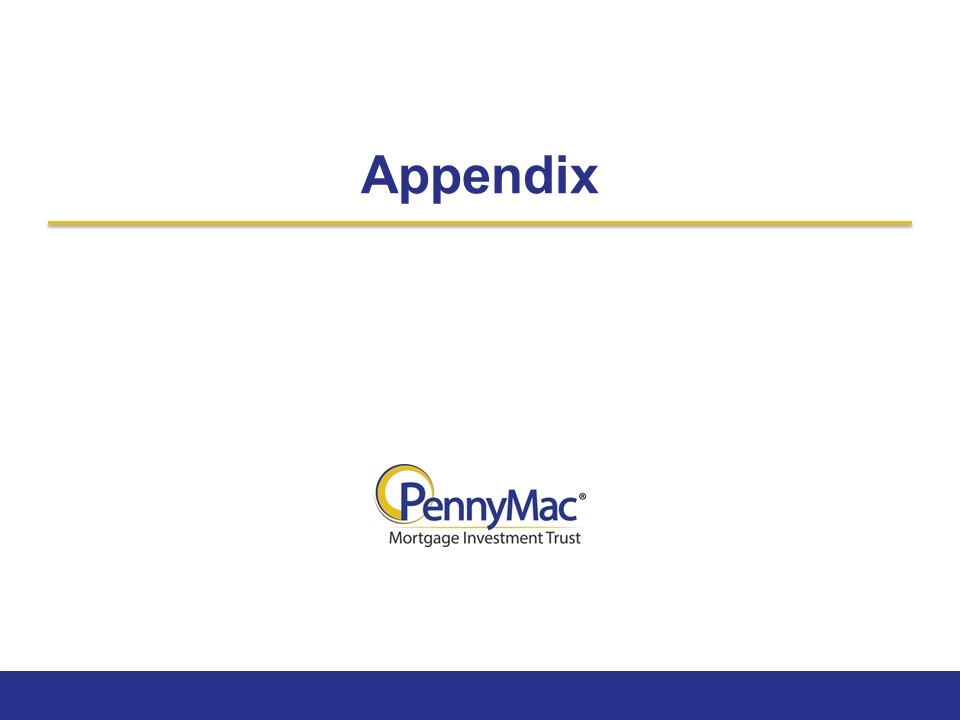
Appendix
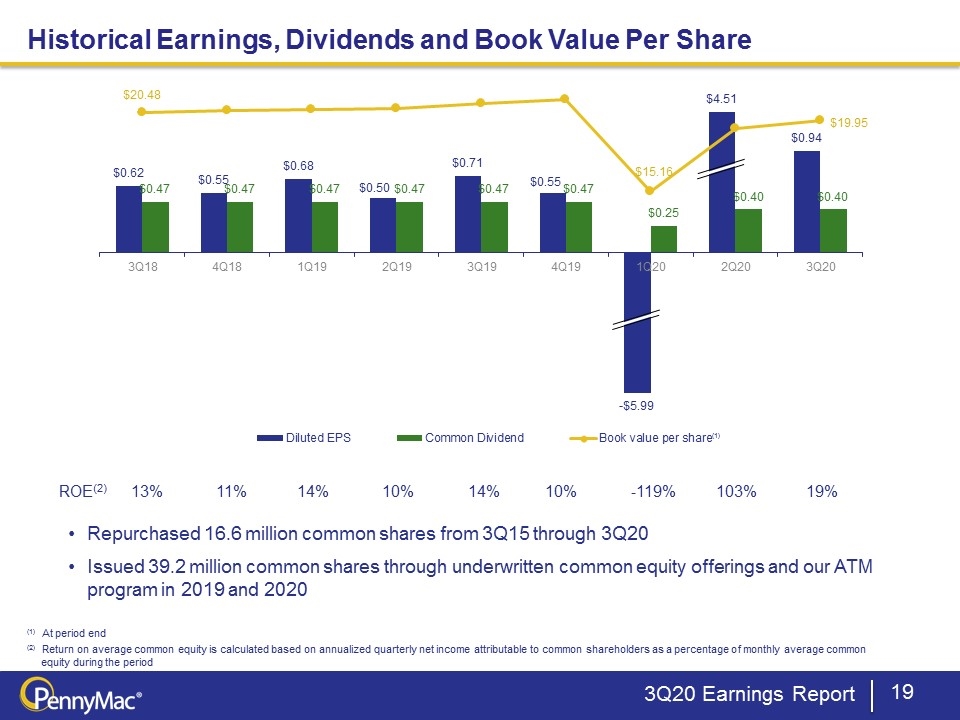
3Q20 Earnings Report (1) At period end (2) Return on average common equity is calculated based on annualized quarterly net income attributable to common shareholders as a percentage of monthly average common equity during the period Historical Earnings, Dividends and Book Value Per Share Repurchased 16.6 million common shares from 3Q15 through 3Q20 Issued 39.2 million common shares through underwritten common equity offerings and our ATM program in 2019 and 2020 ROE(2) 13% 11% 14% 10% 14% 10% -119% 103% 19% (1)
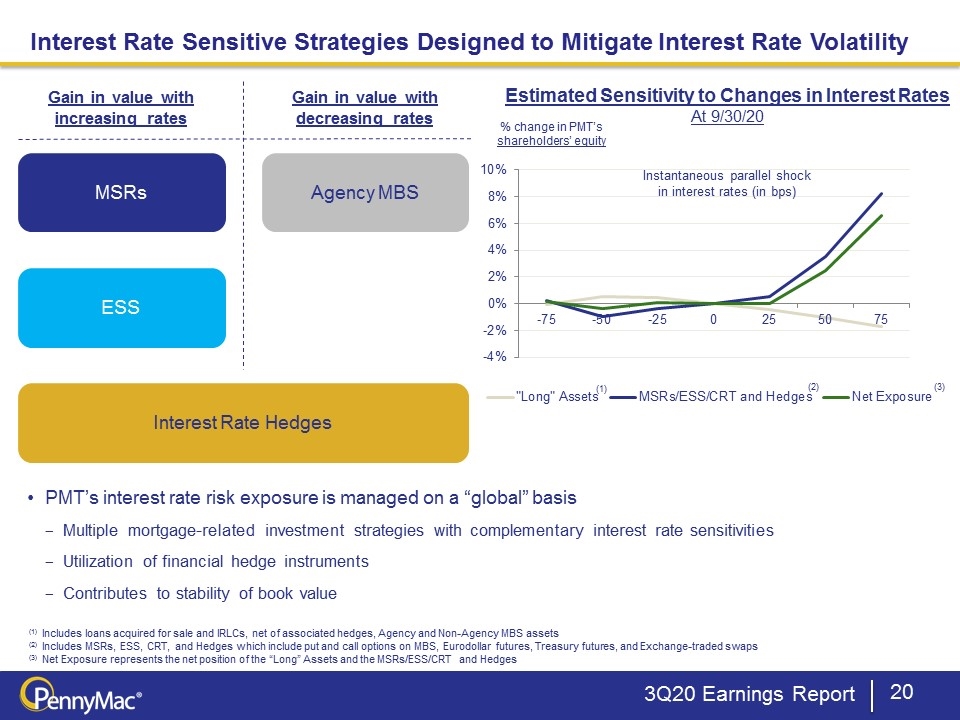
3Q20 Earnings Report Estimated Sensitivity to Changes in Interest Rates At 9/30/20 Instantaneous parallel shock in interest rates (in bps) Interest Rate Sensitive Strategies Designed to Mitigate Interest Rate Volatility % change in PMT’s shareholders’ equity (1) (2) (3) Gain in value with increasing rates Gain in value with decreasing rates MSRs ESS Agency MBS Interest Rate Hedges PMT’s interest rate risk exposure is managed on a “global” basis Multiple mortgage-related investment strategies with complementary interest rate sensitivities Utilization of financial hedge instruments Contributes to stability of book value (1) Includes loans acquired for sale and IRLCs, net of associated hedges, Agency and Non-Agency MBS assets (2) Includes MSRs, ESS, CRT, and Hedges which include put and call options on MBS, Eurodollar futures, Treasury futures, and Exchange-traded swaps (3) Net Exposure represents the net position of the “Long” Assets and the MSRs/ESS/CRT and Hedges
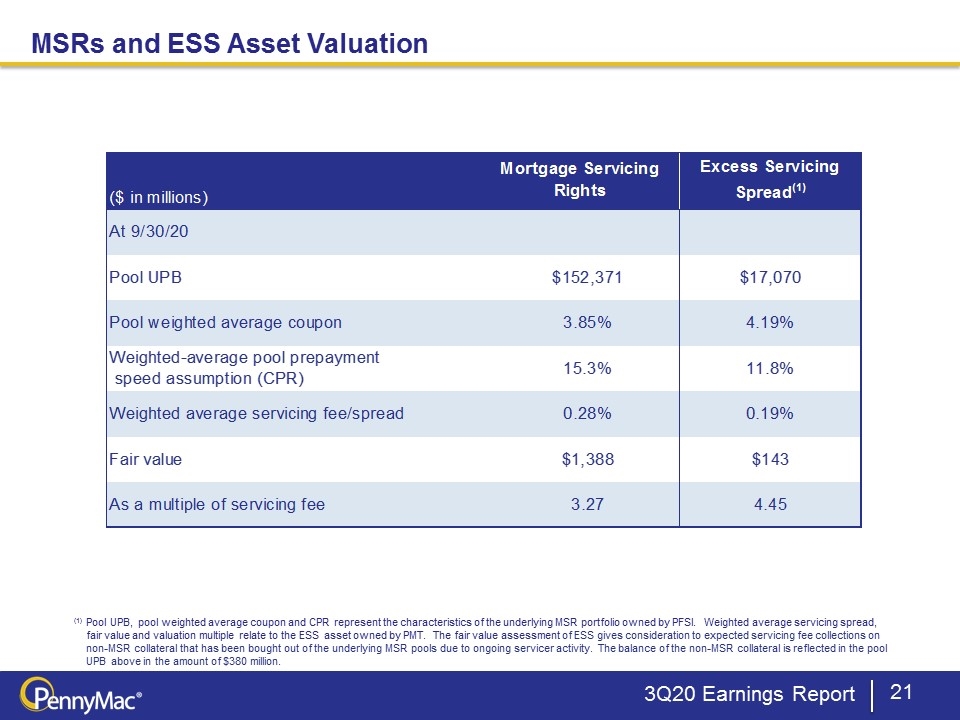
MSRs and ESS Asset Valuation Unaudited (1) Pool UPB, pool weighted average coupon and CPR represent the characteristics of the underlying MSR portfolio owned by PFSI. Weighted average servicing spread, fair value and valuation multiple relate to the ESS asset owned by PMT. The fair value assessment of ESS gives consideration to expected servicing fee collections on non-MSR collateral that has been bought out of the underlying MSR pools due to ongoing servicer activity. The balance of the non-MSR collateral is reflected in the pool UPB above in the amount of $380 million. 3Q20 Earnings Report
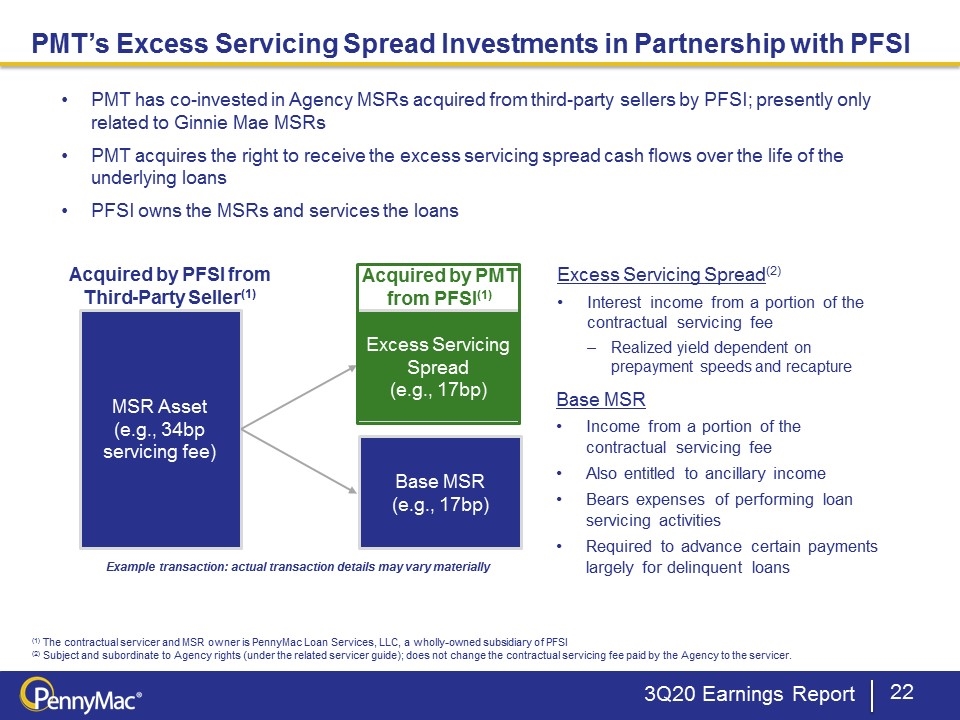
(1) The contractual servicer and MSR owner is PennyMac Loan Services, LLC, a wholly-owned subsidiary of PFSI (2) Subject and subordinate to Agency rights (under the related servicer guide); does not change the contractual servicing fee paid by the Agency to the servicer. Excess Servicing Spread (e.g., 17bp) MSR Asset (e.g., 34bp servicing fee) Acquired by PFSI from Third-Party Seller(1) PMT has co-invested in Agency MSRs acquired from third-party sellers by PFSI; presently only related to Ginnie Mae MSRs PMT acquires the right to receive the excess servicing spread cash flows over the life of the underlying loans PFSI owns the MSRs and services the loans Excess Servicing Spread(2) Interest income from a portion of the contractual servicing fee Realized yield dependent on prepayment speeds and recapture Base MSR Income from a portion of the contractual servicing fee Also entitled to ancillary income Bears expenses of performing loan servicing activities Required to advance certain payments largely for delinquent loans Base MSR (e.g., 17bp) Acquired by PMT from PFSI(1) Example transaction: actual transaction details may vary materially PMT’s Excess Servicing Spread Investments in Partnership with PFSI 3Q20 Earnings Report
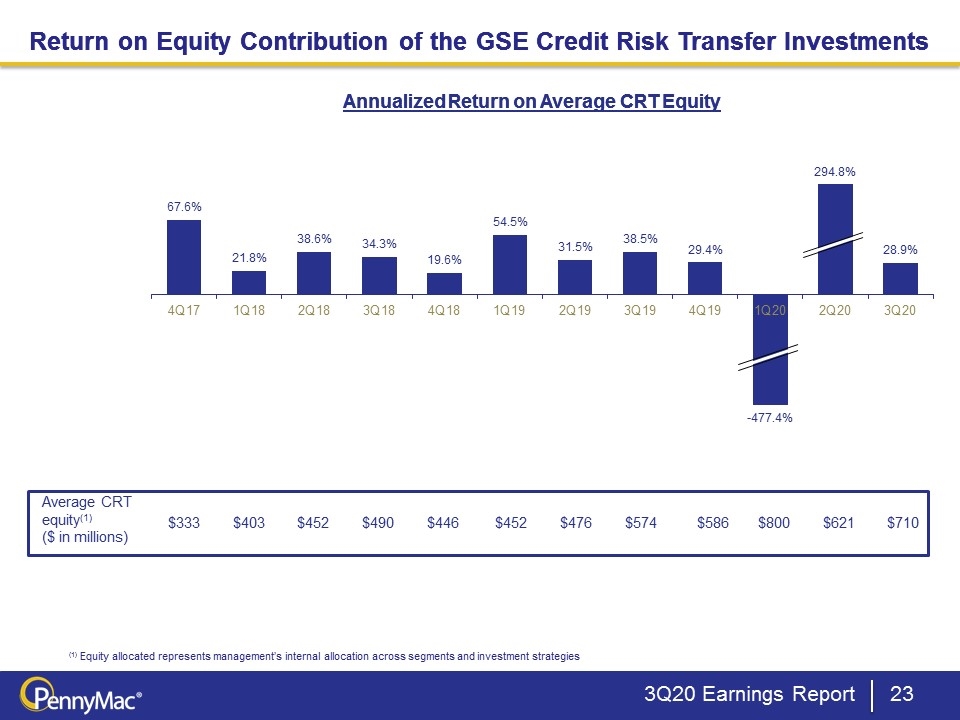
Return on Equity Contribution of the GSE Credit Risk Transfer Investments 3Q20 Earnings Report Annualized Return on Average CRT Equity (1) Equity allocated represents management’s internal allocation across segments and investment strategies Return on Equity Contribution of the GSE Credit Risk Transfer Investments Annualized Return on Average CRT Equity Average CRT equity(1) ($ in millions) $333 $403 $452 $490 $446 $452 $476 $574 $586 $800 $621 $710
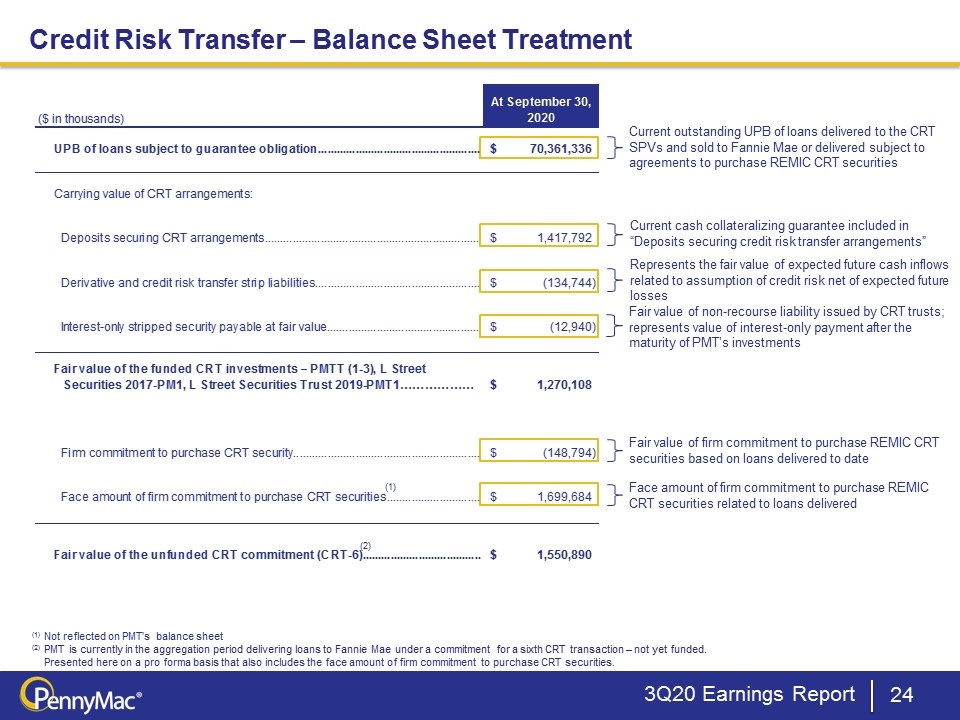
Current outstanding UPB of loans delivered to the CRT SPVs and sold to Fannie Mae or delivered subject to agreements to purchase REMIC CRT securities Credit Risk Transfer – Balance Sheet Treatment Current cash collateralizing guarantee included in “Deposits securing credit risk transfer arrangements” Represents the fair value of expected future cash inflows related to assumption of credit risk net of expected future losses Fair value of firm commitment to purchase REMIC CRT securities based on loans delivered to date Face amount of firm commitment to purchase REMIC CRT securities related to loans delivered 3Q20 Earnings Report Fair value of non-recourse liability issued by CRT trusts; represents value of interest-only payment after the maturity of PMT’s investments (1) (1) Not reflected on PMT’s balance sheet (2) PMT is currently in the aggregation period delivering loans to Fannie Mae under a commitment for a sixth CRT transaction – not yet funded. Presented here on a pro forma basis that also includes the face amount of firm commitment to purchase CRT securities. (2)
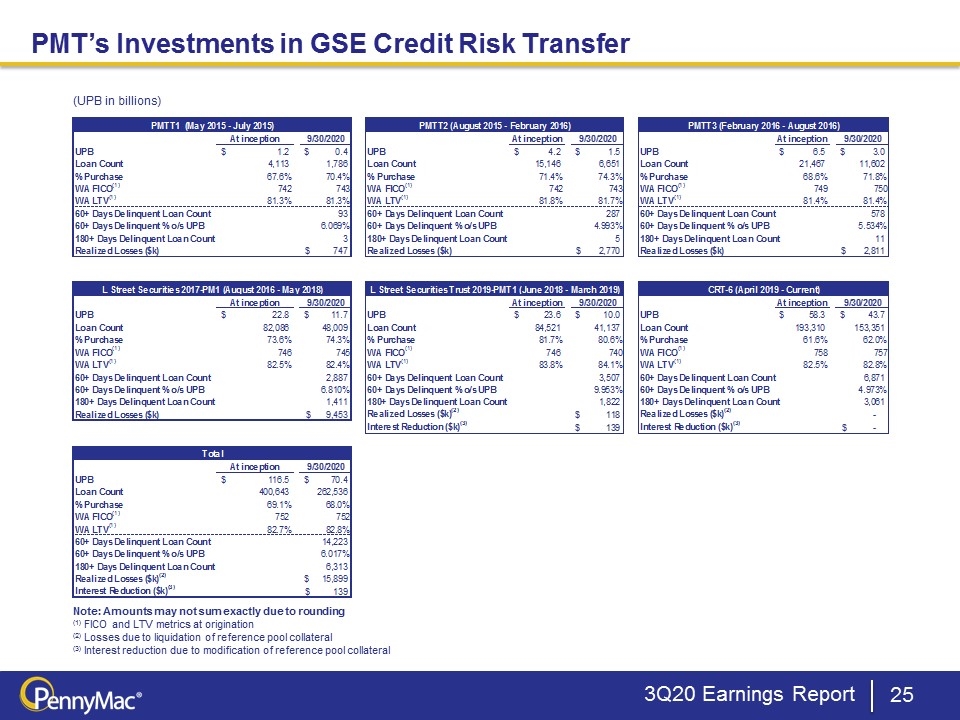
PMT’s Investments in GSE Credit Risk Transfer 3Q20 Earnings Report Note: Amounts may not sum exactly due to rounding (1) FICO and LTV metrics at origination (2) Losses due to liquidation of reference pool collateral (3) Interest reduction due to modification of reference pool collateral (UPB in billions)
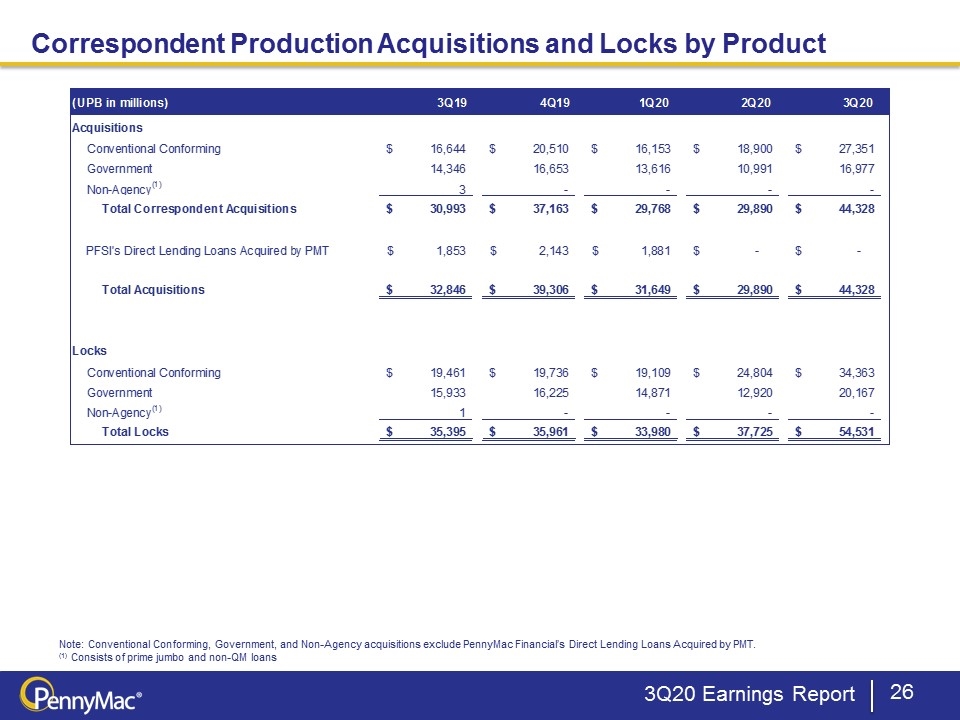
3Q20 Earnings Report Correspondent Production Acquisitions and Locks by Product Note: Conventional Conforming, Government, and Non-Agency acquisitions exclude PennyMac Financial’s Direct Lending Loans Acquired by PMT. (1) Consists of prime jumbo and non-QM loans

























